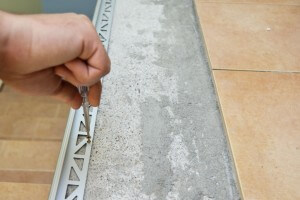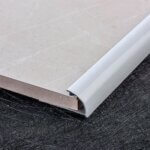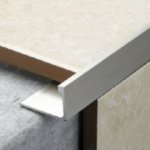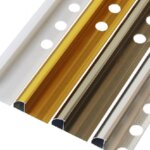Aluminum tile edge trims types and How to install it
Aluminum tile edge trims types and How to install it
Aluminum tile trims types and how to install it
Aluminum tile edge trim are the pieces that finish the exposed edges of a tile installation.
They may be installed on the front of a counter, the edge of the shower or where a tile floor meets another flooring material.
There are numerous types of tile edge options available, and many have different installation concerns.
Installed properly, they will help finish your tile installation.
Bullnose edge trim Installation
If you’re installing bullnose tiles around the perimeter of a shower or at the top of a wall of tiles, the bullnose can be set using the same method used to install the rest of the tiles.
The mortar is combed with the notched side of the trowel out to the edge of where the tiles, or edge pieces, will be installed.
The bullnose tiles are set into the mortar at a slight angle, then twisted straight into place.
If the bullnose are being set into a tight area, they can be back buttered or have the mortar applied to their backs prior to installation.
Metal Edge Trims Installation
Metal edge profiles are used on both floor and wall installations.
They help protect the edges of the tile, while providing a clean, modern look.
These metal strips are shaped like an “L,” with the long arm going beneath the tile and the short arm covering the tile’s edge.
Metal edge profiles are installed by combing the mortar out to the edge of the installation.
The long arm of the “L” is pressed into the mortar.
Additional mortar is combed on top of the metal strip, then the tile is laid over it so its edge comes up against the short arm, which covers it.
Counter Edge Trim
There are several different tile profiles that can be installed on the edge of a counter.
Bullnose, V-cap, sink rail, Prescott and Martel are just a few of the options available.
They all install the same way, however. They are laid before the rest of the counter is tiled.
First the tile adhesive is applied to the counter’s edge with a caulking gun.
Tiles that have a flat back, such as bullnose tiles, are pressed directly into the adhesive on the edge.
Tiles that have an “open” back, such as V-caps and sink rails, are covered on the back with an additional layer of mortar in a process known as back buttering.
The tiles are then pressed onto the counter’s edge.
Specialty Trim Installation
Bullnose tiles are not the only trim options available for walls. Sometimes chair rail tiles, cove tiles, quarter-rounds, pencil tiles or listellos are used.
Some of these tiles have flat backs, like the bullnose, and are installed just like the field tile that are being used.
If the tiles have a rounded, or concave back, however, they must be back buttered by spreading the adhesive onto their backs with a trowel before installing them on the wall.
Doing so ensures good mortar coverage, which will prolong the life of the installation.
Honstar Aluminum Products offers total solution for floor covering aluminum profiles, contact us now to get a reliable no-obligation quote on your aluminum tile trim products!
Get Free Samples And Mold List Here











